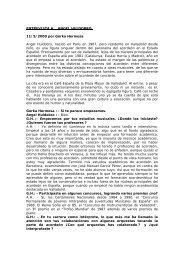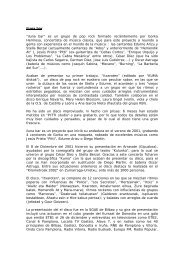The Accordion in the 19th Century - Gorka Hermosa
The Accordion in the 19th Century - Gorka Hermosa
The Accordion in the 19th Century - Gorka Hermosa
Create successful ePaper yourself
Turn your PDF publications into a flip-book with our unique Google optimized e-Paper software.
II.2.4- <strong>Accordion</strong> with registers<br />
In 1846 Jacob Alexandre <strong>in</strong>vents registers. In <strong>the</strong> second half of <strong>the</strong> 19 th c.,<br />
accordions keep grow<strong>in</strong>g <strong>in</strong> tessitura and complexity. [19, 75, 202]<br />
Fig. 53: Soprani (Italy, c.1870) 97 . Fig. 54: Austria (c.1880) 98 .<br />
II.2.5- <strong>Accordion</strong> with keys on <strong>the</strong> right manual<br />
In 1853 Auguste Alexandre Titeux and Auguste Théopile Rousseau 99 patented<br />
<strong>the</strong> accordéon-orgue, <strong>the</strong> first unisonoric accordion with a piano keyboard. In <strong>the</strong><br />
extension to <strong>the</strong> patent made on 11/11/1853, <strong>the</strong>y added Constant Busson as <strong>the</strong><br />
concessionaire of <strong>the</strong> patent; fur<strong>the</strong>rmore <strong>the</strong>y <strong>in</strong>troduce a foot for <strong>the</strong> accordion: Here<br />
we have <strong>the</strong> page for that patent: [66]<br />
Fig. 55: Patent by Titeux-Rousseau (France, 1853) 100 .<br />
97<br />
Fig. taken from: http://www.musicantic.eu/free-reeds-<strong>in</strong>struments/accordion/diatonic-accordion-by-paolosoprani_1847_uk_D.html<br />
98<br />
Fig. taken from: http://pdbzro.com/jargon/musique/diatonique/histoire/galerie.html<br />
99<br />
<strong>The</strong>re is great confusion regard<strong>in</strong>g <strong>the</strong> <strong>in</strong>vention of <strong>the</strong> right manual with keys. Accord<strong>in</strong>g to many authors, it was <strong>in</strong> 1852 when<br />
Philip Joseph Bouton (named Busson accord<strong>in</strong>g some o<strong>the</strong>r sources) <strong>in</strong>vented <strong>in</strong> Paris <strong>the</strong> harmoniflute. This detail is wrong, as we<br />
have proved <strong>in</strong> fig 69. We cannot ascribe <strong>the</strong> paternity of <strong>the</strong> right manual with keys to <strong>the</strong> 1856 harmoni-flute by Mayer Marix,<br />
s<strong>in</strong>ce Titeux-Rousseau’s <strong>in</strong>vention took place earlier. Accord<strong>in</strong>g to Maurer [138, 172] and Grove [253], Busson <strong>in</strong>vented it <strong>in</strong> 1855,<br />
<strong>the</strong>refore <strong>the</strong> first <strong>in</strong>strument of this type was <strong>the</strong> clavierharmonika <strong>in</strong>vented <strong>in</strong> Viena by Matthäus Bauer <strong>in</strong> 1854, with diatonic left<br />
manual and, like <strong>the</strong> harmonium, was also played horizontally. Never<strong>the</strong>less, we show a picture of <strong>the</strong> clavierharmonika from<br />
Hohner Archiv [232] without MII, <strong>the</strong>n, Grove’ s [253] and Maurer’s [138, 186] description is wrong. Apart from this, both <strong>the</strong>se<br />
sources claim that this left keyboard was <strong>the</strong> same as Wal<strong>the</strong>r’s from 1850, so <strong>the</strong>ir credit is questioned and makes it difficult to<br />
prove that Wal<strong>the</strong>r’s accordion corresponds <strong>the</strong> description that <strong>the</strong>y defend. [66, 186, 232, 253]<br />
100<br />
Fig. taken from: Dieterlen [66] page 829.<br />
26




